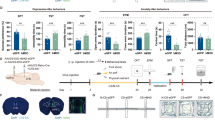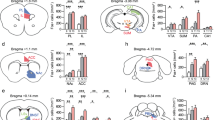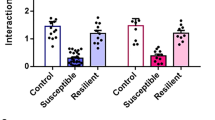Abstract
Clinical studies have shown that the mediodorsal thalamus (MD) may play an important role in the development of depression. However, the molecular and circuit mechanisms by which the mediodorsal thalamus (MD) participates in the pathological processes of depression remain unclear. Here, we show that in male chronic social defeat stress (CSDS) mice, the calcium signaling activity of glutamatergic neurons in MD is reduced. By combining conventional neurotracer and transneuronal virus tracing techniques, we identify a synaptic circuit connecting MD and medial prefrontal cortex (mPFC) in the mouse. Brain slice electrophysiology and fiber optic recordings reveal that the reduced activity of MD glutamatergic neurons leads to an excitatory-inhibitory imbalance of pyramidal neurons in mPFC. Furthermore, activation of MD glutamatergic neurons restores the electrophysiological properties abnormal in mPFC. Optogenetic activation of the MD-mPFC circuit ameliorates anxiety and depression-like behaviors in CSDS mice. Taken together, these data support the critical role of MD-mPFC circuit on CSDS-induced depression-like behavior and provide a potential mechanistic explanation for depression.
This is a preview of subscription content, access via your institution
Access options
Subscribe to this journal
Receive 13 print issues and online access
$259.00 per year
only $19.92 per issue
Buy this article
- Purchase on Springer Link
- Instant access to full article PDF
Prices may be subject to local taxes which are calculated during checkout





Similar content being viewed by others
References
Belda X, Fuentes S, Daviu N, Nadal R, Armario A. Stress-induced sensitization: the hypothalamic-pituitary-adrenal axis and beyond. Stress. 2015;18:269–79.
Ulrich-Lai YM, Herman JP. Neural regulation of endocrine and autonomic stress responses. Nat Rev Neurosci. 2009;10:397–409.
Ding Y, Dai J. Advance in stress for depressive disorder. Adv Exp Med Biol. 2019;1180:147–78.
Richter-Levin G, Xu L. How could stress lead to major depressive disorder? Ibro Rep. 2018;4:38–43.
Klengel T, Binder EB. Gene-environment interactions in major depressive disorder. Can J Psychiatry. 2013;58:76–83.
Brown EC, Clark DL, Hassel S, Macqueen G, Ramasubbu R. Intrinsic thalamocortical connectivity varies in the age of onset subtypes in major depressive disorder. Neuropsychiatr Dis Treat. 2019;15:75–82.
Sherman SM, Guillery RW. Functional organization of thalamocortical relays. J Neurophysiol. 1996;76:1367–95.
Guillery RW. Anatomical evidence concerning the role of the thalamus in corticocortical communication: a brief review. J Anat. 1995;187:583–92.
Mitchell AS. The mediodorsal thalamus as a higher order thalamic relay nucleus important for learning and decision-making. Neurosci Biobehav Rev. 2015;54:76–88.
De Witte L, Brouns R, Kavadias D, Engelborghs S, De Deyn PP, Marien P. Cognitive, affective and behavioural disturbances following vascular thalamic lesions: a review. Cortex. 2011;47:273–319.
Van der Werf YD, Scheltens P, Lindeboom J, Witter MP, Uylings HB, Jolles J. Deficits of memory, executive functioning and attention following infarction in the thalamus; A study of 22 cases with localised lesions. Neuropsychologia. 2003;41:1330–44.
Haber SN. The primate basal ganglia: parallel and integrative networks. J Chem Neuroanat. 2003;26:317–30.
Li W, Liu J, Skidmore F, Liu Y, Tian J, Li K. White matter microstructure changes in the thalamus in Parkinson disease with depression: a diffusion tensor mr imaging study. Ajnr Am J Neuroradiol. 2010;31:1861–6.
Cardoso EF, Maia FM, Fregni F, Myczkowski ML, Melo LM, Sato JR, et al. Depression in Parkinson’s disease: convergence from voxel-based morphometry and functional magnetic resonance imaging in the limbic thalamus. Neuroimage. 2009;47:467–72.
Golden SA, Covington HR, Berton O, Russo SJ. Corrigendum: a standardized protocol for repeated social defeat stress in mice. Nat Protoc. 2015;10:643.
Morel C, Montgomery SE, Li L, Durand-De CR, Teichman EM, Juarez B, et al. Midbrain projection to the basolateral amygdala encodes anxiety-like but not depression-like behaviors. Nat Commun. 2022;13:1532.
Shepard R, Page CE, Coutellier L. Sensitivity of the prefrontal gabaergic system to chronic stress in male and female mice: relevance for sex differences in stress-related disorders. Neuroscience. 2016;332:1–12.
Mclaughlin RJ, Hill MN, Dang SS, Wainwright SR, Galea LA, Hillard CJ, et al. Gorzalka BB. Upregulation of cb(1) receptor binding in the ventromedial prefrontal cortex promotes proactive stress-coping strategies following chronic stress exposure. Behav Brain Res. 2013;237:333–7.
Jiang X, Wang G, Lee AJ, Stornetta RL, Zhu JJ. The organization of two new cortical interneuronal circuits. Nat Neurosci. 2013;16:210–8.
Kobayashi M, Hayashi Y, Fujimoto Y, Matsuoka I. Decreased parvalbumin and somatostatin neurons in medial prefrontal cortex in brinp1-ko mice. Neurosci Lett. 2018;683:82–8.
Miller OH, Bruns A, Ben Ammar I, Mueggler T, Hall BJ. Synaptic regulation of a thalamocortical circuit controls depression-related behavior. Cell Rep. 2017;20:1867–80.
Zhu X, Tang HD, Dong WY, Kang F, Liu A, Mao Y, et al. Distinct thalamocortical circuits underlie allodynia induced by tissue injury and by depression-like states. Nat Neurosci. 2021;24:542–53.
Huang L, Xi Y, Peng Y, Yang Y, Huang X, Fu Y, et al. A visual circuit related to habenula underlies the antidepressive effects of light therapy. Neuron. 2019;102:128–42.
Dwyer JM, Maldonado-Aviles JG, Lepack AE, Dileone RJ, Duman RS. Ribosomal protein s6 kinase 1 signaling in prefrontal cortex controls depressive behavior. Proc Natl Acad Sci USA. 2015;112:6188–93.
Jiang B, Wang W, Wang F, Hu ZL, Xiao JL, Yang S, et al. The stability of nr2b in the nucleus accumbens controls behavioral and synaptic adaptations to chronic stress. Biol Psychiatry. 2013;74:145–55.
Krishnan V, Nestler EJ. Linking molecules to mood: new insight into the biology of depression. Am J Psychiatry. 2010;167:1305–20.
Lee AT, Cunniff MM, See JZ, Wilke SA, Luongo FJ, Ellwood IT, et al. Vip interneurons contribute to avoidance behavior by regulating information flow across hippocampal-prefrontal networks. Neuron. 2019;102:1223–34.
Arnsten AF. Stress weakens prefrontal networks: molecular insults to higher cognition. Nat Neurosci. 2015;18:1376–85.
Cho JH, Deisseroth K, Bolshakov VY. Synaptic encoding of fear extinction in mpfc-amygdala circuits. Neuron. 2013;80:1491–507.
Arnsten AF. Stress signalling pathways that impair prefrontal cortex structure and function. Nat Rev Neurosci. 2009;10:410–22.
Delevich K, Tucciarone J, Huang ZJ, Li B. The mediodorsal thalamus drives feedforward inhibition in the anterior cingulate cortex via parvalbumin interneurons. J Neurosci. 2015;35:5743–53.
Dong Z, Chen W, Chen C, Wang H, Cui W, Tan Z, et al. Cul3 deficiency causes social deficits and anxiety-like behaviors by impairing excitation-inhibition balance through the promotion of cap-dependent translation. Neuron. 2020;105:475–90.
Selimbeyoglu A, Kim CK, Inoue M, Lee SY, Hong A, Kauvar I, et al. Deisseroth K. Modulation of prefrontal cortex excitation/inhibition balance rescues social behavior in cntnap2-deficient mice. Sci Transl Med. 2017;9:eaah6733.
Yizhar O, Fenno LE, Prigge M, Schneider F, Davidson TJ, O’Shea DJ, et al. Neocortical excitation/inhibition balance in information processing and social dysfunction. Nature. 2011;477:171–8.
Giraldo-Chica M, Rogers BP, Damon SM, Landman BA, Woodward ND. Prefrontal-thalamic anatomical connectivity and executive cognitive function in schizophrenia. Biol Psychiatry. 2018;83:509–17.
Nelson SB, Valakh V. Excitatory/inhibitory balance and circuit homeostasis in autism spectrum disorders. Neuron. 2015;87:684–98.
Coghlan S, Horder J, Inkster B, Mendez MA, Murphy DG, Nutt DJ. Gaba system dysfunction in autism and related disorders: from synapse to symptoms. Neurosci Biobehav Rev. 2012;36:2044–55.
Yoon T, Okada J, Jung MW, Kim JJ. Prefrontal cortex and hippocampus subserve different components of working memory in rats. Learn Mem. 2008;15:97–105.
Ferguson BR, Gao WJ. Thalamic control of cognition and social behavior via regulation of gamma-aminobutyric acidergic signaling and excitation/inhibition balance in the medial prefrontal cortex. Biol Psychiatry. 2018;83:657–69.
Warden MR, Selimbeyoglu A, Mirzabekov JJ, Lo M, Thompson KR, Kim SY, et al. A prefrontal cortex-brainstem neuronal projection that controls response to behavioural challenge. Nature. 2012;492:428–32.
Acknowledgements
We appreciate the technical support by Dr. Bin Jiang at Zhongshan School of Medicine, Sun Yat-sen University.
Funding
This work was supported by the National Natural Science Foundation of China (81771144, 32200832), the Natural Science Foundation of Guangdong Province, China (2021A1515011134, 2022A1515012553).
Author information
Authors and Affiliations
Contributions
GQG, JFZ and FL conceived and designed the study. FL, XFZ and HJW performed most of the experiments. LHM, MYC, LYF, XYY and YQH helped to establish the CSDS animal models and perform behavioral tests. DLL, YFL and KMX contributed to data analysis. FL and JFZ wrote the paper. GQG reviewed and edited the manuscript. All the authors have read and approved the final version of the manuscript.
Corresponding authors
Ethics declarations
Competing interests
The authors declare no competing interests.
Additional information
Publisher’s note Springer Nature remains neutral with regard to jurisdictional claims in published maps and institutional affiliations.
Supplementary information
Rights and permissions
Springer Nature or its licensor (e.g. a society or other partner) holds exclusive rights to this article under a publishing agreement with the author(s) or other rightsholder(s); author self-archiving of the accepted manuscript version of this article is solely governed by the terms of such publishing agreement and applicable law.
About this article
Cite this article
Li, F., Zheng, X., Wang, H. et al. Mediodorsal thalamus projection to medial prefrontal cortical mediates social defeat stress-induced depression-like behaviors. Neuropsychopharmacol. (2024). https://doi.org/10.1038/s41386-024-01829-y
Received:
Revised:
Accepted:
Published:
DOI: https://doi.org/10.1038/s41386-024-01829-y



